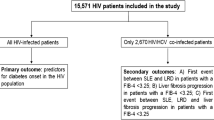Abstract
Background
We sought to determine the effect of statin therapy on serum AST and ALT levels in a cohort of HCV-infected veterans with well-characterized liver disease.
Study
We examined liver biopsy records of consecutive HCV-infected patients and identified 20 patients who were prescribed statins. We matched them on age, stage of fibrosis, and time between HCV diagnosis and statin start dates with up to four HCV-infected patients who did not use statins. ALT and AST values from up to four time points within 1 year of follow-up were abstracted from the medical record. We compared median ALT and AST levels using Wilcoxon–Mann–Whitney tests and assessed changes in ALT and AST over time between the statin and non-statin groups using a non-parametric repeated measures ANOVA model, adjusting for the matching factors, receipt of HCV treatment, BMI, and diabetes.
Results
Patients prescribed statins had higher median BMIs, were more likely to have diabetes, and had higher total cholesterol levels. Median baseline ALT levels were higher among those prescribed statins (P = 0.04) while median baseline AST levels were lower among statin users (P = 0.03). From baseline to follow-up, the median decreases in both ALT (−13.5 vs. −4.0) and AST (−4.5 vs. −0.5) were significantly larger among statin users compared to non-statin users (P = 0.03 and P = 0.0007, respectively) even after adjustment.
Conclusions
Among HCV-infected patients AST and ALT levels for those prescribed statins decreased over a 6 to 12-month follow-up period compared to patients not taking statins.
Similar content being viewed by others
References
Kung HC, Hoyert DL, Xu JQ, et al. Deaths: final data for 2005. National vital statistics reports, vol 56, no 10. Hyattsville, MD: National Center for Health Statistics; 2008.
Lloyd-Jones D, Adams R, Carnethos M, et al. Heart disease and stroke statistics—2009 update: a report from the American Heart Association statistics committee and stroke statistics subcommittee. Circulation. 2009;119:e1–e161.
Centers for Disease Control and Prevention (CDC). State-specific cholesterol screening trends: United States, 1991–1999. MMWR. 2000;49:750–5.
Gotto AM. Statins: powerful drugs for lowering cholesterol. Circulation. 2002;105:1514–1516.
Pasternak RC, Smith SC, Bairey-Merz CN, et al. ACC/AHA/NHLBI clinical advisory on the use and safety of statins. JACC. 2002;3:567–572.
National Cholesterol Education Program (NCEP). Expert panel on detection, evaluation, and treatment of high blood cholesterol in adults (adult treatment panel III) final report. Circulation. 2002;06:3143–3421.
De Denus S, Spinler SA, Miller K, et al. Statins and liver toxicity: a meta-analysis. Pharmacotherapy. 2004;24:584–591.
Khorashadi S, Hasson NK, Cheung RC. Incidence of statin hepatotoxicity in patients with Hepatitis C. Clin Gastroenterol Hepatol. 2006;4(7):902–907.
Gibson K, Rindone JP. Experience with statin use in patients with chronic hepatitis C infection. Am J Cardiol. 2005;96(9):1278–1279.
Segarra-Newnham M, Parra D, Martin-Cooper EM. Effectiveness and hepatoxicity of statins in men seropositive for hepatitis C virus. Pharmacotherapy. 2007;27(6):845–851.
Cohen DE, Anania FA, Chalasani N. An assessment of statin safety by hepatologists. Am J Cardiol. 2006;97(suppl):77C–81C.
Ye J, Wang C, Sumpter R Jr, et al. Disruption of hepatitis C virus RNA replication through inhibition of host protein geranylgeranylation. Proc Natl Acad Sci USA. 2003;100(26):15865–15870.
Kapadia SB, Chisari FV. HCV RNA replication is regulated by host geranylgeranylation and fatty acids. Proc Natl Acad Sci USA. 2005;7:2561–2566.
Ikeda M, Abe K, Yamada M, et al. Different anti-HCV profiles of statins and their potential for combination therapy with interferon. Hepatology. 2006;44(1):117–125.
Bader T, Fazili J, Madhoun M, et al. Fluvastatin inhibits hepatitis C replication in humans. Am J Gastroenterol. 2008;103(6):1383–1389.
Avins AL, Manos MM, Ackerson L, et al. Hepatic effects of lovastatin exposure in patients with liver disease: a retrospective cohort study. Drug Saf. 2008;31(4):325–334.
Wackerly DD, Mendenhall W III, Scheaffer RL. Mathematical statistics with applications. Belmont, CA: Wadsworth Publishing Company, Duxbury Press; 1996.
Bhardwaj SS, Chalasani N. Lipid-lowering agents that cause drug-induced hepatotoxicity. Clin Liver Dis. 2007;11:597–613.
Onofrei MD, Butler KL, Fuke DC, et al. Safety of statin therapy in patients with preexisting liver disease. Pharmacotherapy. 2008;28(4):522–529.
Chalasani N, Aljadhey, Kesterson J, et al. Patients with elevated liver enzymes are not at higher risk for statin hepatotoxicity. Gastroenterology. 2004;126:1287–1292.
Lewis JH, Mortensen ME, Zweig S, et al. Efficacy and safety of high-dose pravastatin in hypercholesterolemic patients with well-compensated chronic liver disease: results of a prospective, randomized, double-blind, placebo-controlled, multicenter trial. Hepatology. 2007;46:1453–1463.
Mallat A, Preaux AM, Blazejewski S, et al. Effect of simvastation, an inhibitor of hydroxyl-methylglutaryl coenzyme A reductase, on the growth of human lto cells. Hepatology. 1994;20(6):1589–1594.
Rombouts K, Kisanga E, Hellemans K, et al. Effect of HMG-CoA reductase inhibitors on proliferation and protein synthesis by rat hepatic stellate cells. J Hepatol. 2003;38:564–572.
Wang C, Gale M, Keller B, et al. Identification of FBL2 as a geranylgeranylated cellular protein required for hepatitis C virus RNA replication. Mol Cell. 2005;18:425–434.
Lok AS, Everhart JE, Chung RT, et al. Evolution of hepatic steatosis in patients with advanced hepatitis C: results from the hepatitis C antiviral long-term treatment against cirrhosis (HALT-C) trial. Hepatology. 2009;49:1828–1837.
Acknowledgments
The work was partly supported by NIH K24DK078154-03 for Dr. El-Serag, and Public Health Service Grant DK56338, which funds the Texas Medical Center Digestive Disease Center.
Author information
Authors and Affiliations
Corresponding author
Rights and permissions
About this article
Cite this article
Henderson, L.M., Patel, S., Giordano, T.P. et al. Statin Therapy and Serum Transaminases Among a Cohort of HCV-Infected Veterans. Dig Dis Sci 55, 190–195 (2010). https://doi.org/10.1007/s10620-009-0959-1
Received:
Accepted:
Published:
Issue Date:
DOI: https://doi.org/10.1007/s10620-009-0959-1




